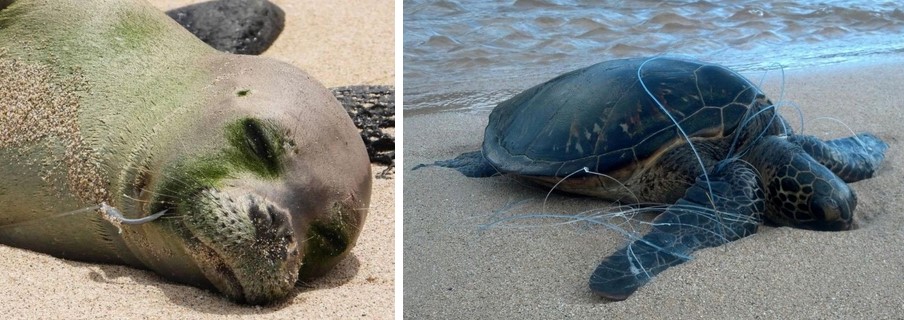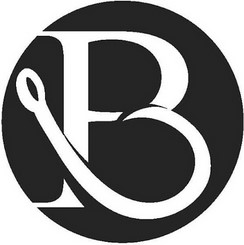2/6/24 – 20 Years of the Barbless Circle Hook Project
In 2004 Kirk Kawamoto, the fishing liaison extension agent at NOAA Pacific Islands Fisheries Science Center (PIFSC), and Earl Miyamoto, the head of the Division of Aquatic Resources (DAR) Protected Species Program (PSP), came together to find a solution to the increasing amount of Hawaiian monk seals and sea turtles getting hooked. The hooks that were causing the most life threatening injuries to these animals were barbed circle hooks, as well as the fishing line. Seals often get unintentionally hooked when they get a little too interested in a fisherman’s catch or eat the bait. Sea turtles are like the cows of the sea, and while they are grazing along for limu they can get caught up in hooks and fishing line that gets left behind on the reef, and occasionally like to eat the bait as well. While the fishing line is the most dangerous part to these seals and turtles, the barbed hooks can also cause severe damage if swallowed, and often result in the animal needing surgery. The barb on the hooks also makes it extremely challenging for responders to remove the hooks from these already unhappy animals’ jaws. Kirk and Earl started the Barbless Circle Hook (BCH) Project to raise awareness of this issue and to offer solutions to fishers who shared their concern for aquatic life.

The impacts that shoreline fishing can have on marine species. (Photo credits NOAA fisheries and Mimi Olry)
When the project started in 2004 they had zero funding, but they first began by testing the feasibility of using barbless circle hooks. They tried to answer all the questions fishermen would have before they asked. Bert Kikkawa ran a research project involving the Kewalo Keiki Fishing Conservancy, the Pacific Islands Fisheries Group, and interested fishermen. This study compared barbed vs barbless catch from the shoreline. The study showed that there was no statistical differences in the catches, misses, or losses between the hooks, which was great news, the hooks work! Unfortunately, the formal publication is still unfinished as Bert Kikkawa passed away before completion, but the team produced a poster outlining the results.

The study comparing barbed vs barbless catch from the shoreline.
 Their next steps were to increase the awareness and use of BCHs by Hawaii’s shoreline fishermen, specifically on O‘ahu. They started off by using the BCHs in their own fishing practices, talking story with fishermen, going to fishing stores and tournaments promoting “going barbless”. The use of barbless circle hooks are not just for ulua, but also for whipping, casting, dunking, slide bait, any kind of pole fishing.
Their next steps were to increase the awareness and use of BCHs by Hawaii’s shoreline fishermen, specifically on O‘ahu. They started off by using the BCHs in their own fishing practices, talking story with fishermen, going to fishing stores and tournaments promoting “going barbless”. The use of barbless circle hooks are not just for ulua, but also for whipping, casting, dunking, slide bait, any kind of pole fishing.
Main reason to fish barbless
- It’s better for the fish. It’s easier to quickly release unwanted catch without causing damage to the fish, which means more and healthier fish for you to catch in the future.
- It’s better for you. Minimize injury to yourself and others, as well as damage to shirt, shorts, and nets.
- It’s better for Hawaii’s protected species. Barbless hooks reduce potential injury in the event of an accidental hooking or entanglement, and allow for quicker release or self-shedding release to reduce trauma and enable a return to normal activities.
- They do work! In 2005 their first major success was when one their teammates, Mitchell Taketa, caught the first ulua using a BCH. Then in 2006 there was major growth for the project with the first two tournaments featuring a barbless category and the first all-barbless tournament. There was also the first over 100 pound ulua caught using barbless hooks when Randall Elarco Jr. reeled in a 117 pounder which is still the record for barbless. That year Randall was given a special 100 Pounder award at the Fishing and Seafood Festival in Honolulu by Honolulu Mayor Mufi Hanneman for his historic catch and an additional special award was given to Mitchell for catching the first barbless circle hook ulua for the project.
In 2007 the barbless self-shedding concept was proven by NOAA staff and volunteers on Hawaii Island. There was a hooked seal that responders were trying to de-hook when the seal threw the BCH from its mouth on its own in front of them! This was pivotal in helping to convince fishermen and researchers of the potential of BCH.

Randall Elarco Jr. record breaking ulua catch and the Tokunaga ulua challenge 2006 vs. 2023. (Photo credits Barbless Circle Hook Project)
In 2008 the amount of tournaments continued to grow, with fishing barbless as a category for 7 tournaments. The popularity of using BCH has continued to increase and it is now a statewide initiative. In 2023 the barbless team continued to promote “going barbless” at 14 fishing tournaments, and at fishing stores in across Hawaii doing pop-ups to give out free hooks, swag, and information. This work will continue on into 2024.
If you would like to try out some barbless hooks for free- message us on our socials:
BCH Instagram & Facebook: @barblesscirclehookproject
Sign up for the newsletter: Click here
Check out these videos the barbless team has recently produced:
Fishing with Barbless Hooks, Part 1
Fishing with Barbless Hooks, Part 2
If you are out fishing and you do accidentally hook a monk seal or a sea turtle please report the event to Hawaii’s Marine Animal Response Hotline: 1-888-256-9840
Please visit our website to learn more about fishing around protected species.

